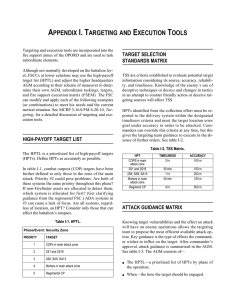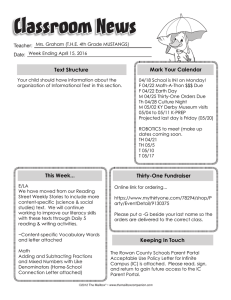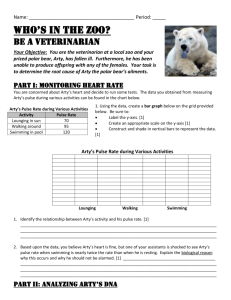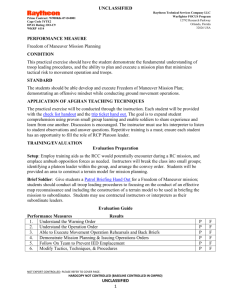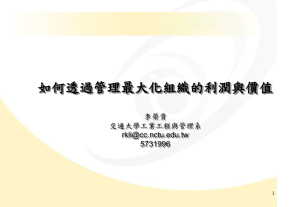A I. T E
advertisement
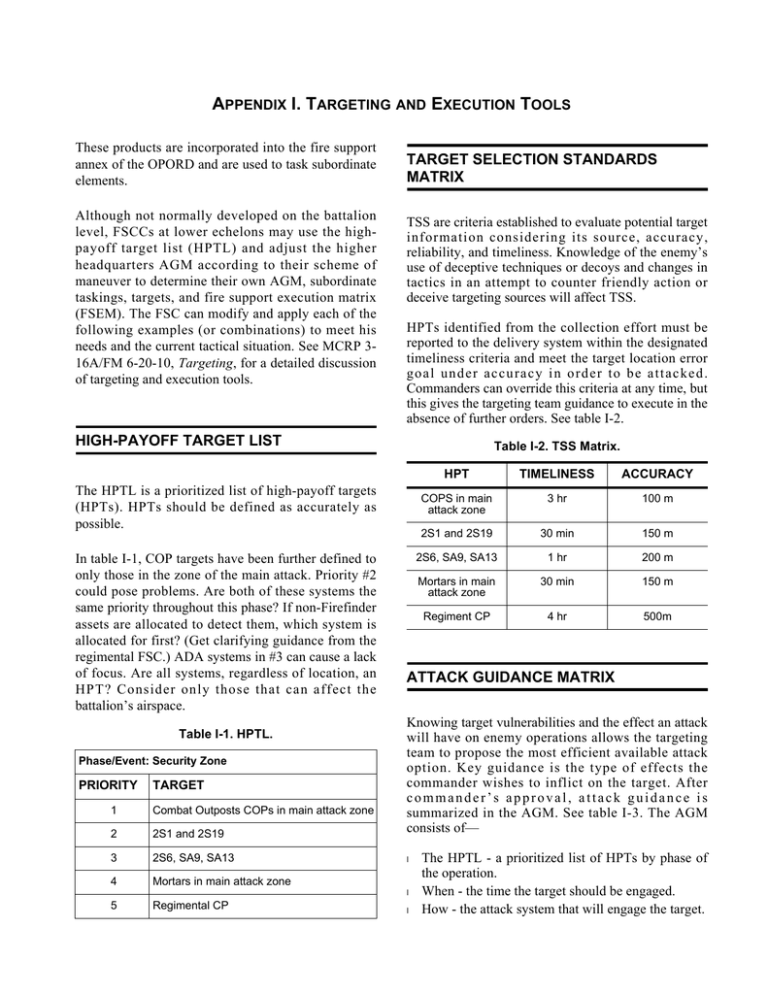
APPENDIX I. TARGETING AND EXECUTION TOOLS These products are incorporated into the fire support annex of the OPORD and are used to task subordinate elements. Although not normally developed on the battalion level, FSCCs at lower echelons may use the highpayoff target list (HPTL) and adjust the higher headquarters AGM according to their scheme of maneuver to determine their own AGM, subordinate taskings, targets, and fire support execution matrix (FSEM). The FSC can modify and apply each of the following examples (or combinations) to meet his needs and the current tactical situation. See MCRP 316A/FM 6-20-10, Targeting, for a detailed discussion of targeting and execution tools. TARGET SELECTION STANDARDS MATRIX TSS are criteria established to evaluate potential target information considering its source, accuracy, reliability, and timeliness. Knowledge of the enemy’s use of deceptive techniques or decoys and changes in tactics in an attempt to counter friendly action or deceive targeting sources will affect TSS. HPTs identified from the collection effort must be reported to the delivery system within the designated timeliness criteria and meet the target location error goal under accuracy in order to be attacked. Commanders can override this criteria at any time, but this gives the targeting team guidance to execute in the absence of further orders. See table I-2. HIGH-PAYOFF TARGET LIST Table I-2. TSS Matrix. The HPTL is a prioritized list of high-payoff targets (HPTs). HPTs should be defined as accurately as possible. In table I-1, COP targets have been further defined to only those in the zone of the main attack. Priority #2 could pose problems. Are both of these systems the same priority throughout this phase? If non-Firefinder assets are allocated to detect them, which system is allocated for first? (Get clarifying guidance from the regimental FSC.) ADA systems in #3 can cause a lack of focus. Are all systems, regardless of location, an HPT? Consider only those that can affect the battalion’s airspace. Table I-1. HPTL. Phase/Event: Security Zone PRIORITY TARGET 1 Combat Outposts COPs in main attack zone 2 2S1 and 2S19 3 2S6, SA9, SA13 4 Mortars in main attack zone 5 Regimental CP HPT TIMELINESS ACCURACY COPS in main attack zone 3 hr 100 m 2S1 and 2S19 30 min 150 m 2S6, SA9, SA13 1 hr 200 m Mortars in main attack zone 30 min 150 m Regiment CP 4 hr 500m ATTACK GUIDANCE MATRIX Knowing target vulnerabilities and the effect an attack will have on enemy operations allows the targeting team to propose the most efficient available attack option. Key guidance is the type of effects the commander wishes to inflict on the target. After commander’s approval, attack guidance is summarized in the AGM. See table I-3. The AGM consists of— l l l The HPTL - a prioritized list of HPTs by phase of the operation. When - the time the target should be engaged. How - the attack system that will engage the target. I-2 _________________________________________________________________________________________________ MCWP 3-16 Guidance for when an asset is to be attacked is summed as immediate, as acquired, and planned. As acquired - these targets will be attacked in the order they are acquired and received by the fire support asset. Immediate takes precedence over as acquired. Planned - targets are not to be attacked but are to be planned for a later time to be attacked as part of a preparation, program or schedule of fires Immediate - the commander wants this target attack as soon as acquired, before any others. MCRP 3-16A/FM 6-20-10 has additional information on the AGM. l l Effect -the desired effects on the target or target system. Remarks - remarks on if BDA is required, whether coordination must take place, etc. l l l Table I-3. Attack Guidance Matrix. HPT WHEN HOW EFFECT COPs P Arty N Plan in initial Prep RISTA and OPs P Arty N Plan in initial Prep 2S1 and 2S3 I CAS (FIXED N Plan in initial Prep 2S6, SA-9, SA-13 P Arty S SEAD for CAS Regt CP A EW/Arty EW/N Coord with ECM prior to Neutralizing Reserve Bn P CAS (fixed) D Intent to attack reserve Bn in EA HOT LEGEND I = IMMEDIATE A = AS ACQUIRED P = PLANNED HPTL/TSS/AGM The FSC can combine one or more tools to meet his requirements. Table I-4 shows the most common attack systems used. Table I-5 shows an HPTL with an AGM. In table I-4, across the top portion of the matrix (prioritized from left to right) are the HPTs by category. Below each category, specific target types can be listed for clarification. Along the left-hand column are the attack systems that can be used to attack the HPTs. At the intersection of the HPT’s column and the attack system row is a box that contains the asset prioritization, TSS, and damage criteria. (See graphic at the bottom of the page.) In the REMARKS S = SUPPRESS N = NEUTRALIZE D = DESTROY EW = JAMMING OR OTHER OFFENSIVE EW top right hand corner of the box is a small number - the asset prioritization. It helps the FSC or watch officer determine which asset to use to attack the target. Artillery is the second choice to attack indirect fire assets. The TSS displays target location error, engagement criteria (how big the target must be to engage), what the target is doing, and the target decay time. The location given by the observer must be within 100m of the target’s location. The target must be larger than platoon size, stationary, and should not have been reported longer than 30 minutes ago. Should the request for fire for the identified target meet the TSS and the asset determined to be first choice to attack the target is unavailable, then artillery would be used to attack an indirect fire asset. Fire Support Coordination in the Ground Combat Element _______________________________________________ Table I-4. HPTL/TSS/AGM. PHASE: 1- DESCRIPTION PRI Arty DTG: HIGH-PAYOFF TARGETS 2 3 ADA MANEUVER SYSTEMS 1 INDIRECT FIRE 1 100M 2 Platoon> 3 Stationary 4 30 Min 2 1 100MM 2 PLT(-) 3 Stationary 4 45 Min ATTACK SYSTEMS N 81 MM RWCAS 1 100M 2 Platoon 3 Stationary 4 30 Min 1 500M 2 Battery 3 Stationary 4 <1 Hour 5 NSFS FWCAS 1 100M 2 PLT(-) 3 Stationary 4 45 Min 3 1 100M 2 CoHq 3 Stationary 4 <45 Min S 1 100M 2 Platoon> 3 Stationary 4 <45 Min 5 1 N 1 100M 2 CoHq 3 Stationary 4 <45 Min 5 S S 3 1 500M 4 2 PLT(-) 3 Stat/Moving 4 <1 Hour D 1 500M 2 2 Platoon> 3 Stat/Moving 4 <1 Hour D 1 500M 3 2 CoHq> 3 Stat/Moving 4 <1 Hour N 1 100M 2 2 PLT(-) 3 Stat/Moving 4 45 Min S 1 100M 4 2 Platoon> 3 Stat/Moving 4 <45 Min S 1 100M 2 2 CoHq> 3 Stat/Moving 4 <45 Min N 1 1KM 5 2 PLT(-) 3 Stat/Moving 4 <1 Hour D 1 1KM 1 2 Platoon> 3 Stat/Moving 4 <1 Hour D 1 1KM 4 2 CoHq> 3 Stat/Moving 4 <1 Hour D 4 1 D Arty N 3 S S 1 1KM 2 >Battery 3 Stationary 4 45 Min 1 100MM 2 Platoon> 3 Stationary 4 <45 Min REMARKS S D 1 100M 2 Platoon> 3 Stationary 4 30 Min 1 4 RSTA 1 INDIRECT FIRE 1 100M 2 Platoon> 3 Stationary 4 30 Min Asset Prioritization 2 Target Selection Standards N Damage Criteria I-3 I-4 _________________________________________________________________________________________________ MCWP 3-16 Table I-5. High-Payoff Target List/Attack Guidance Matrix. EVENT OR PHASE: Attack to Objective C PRI CATEGORY HPTs WHEN HOW COMMENTS 1 ADA SA-8, SA-11,SA-15 A/P N 2 FIRE SPT Arty CP MRL, C/B Wpns I N/EW 3 ENGINEER Bridging Units, pontoons A N 4 C3 MRR, MRD CP A N/EW 5 MANEUVER 1st Ech/lead division A N 6 RISTA Fwd intercept DF nodes I N - NUKE/CHEM I D Need BDA - REC A N Not HPT - CLASS III POL A N Not Hpt - CLASS V AMMO A N Not HPT - CLASS IX MAINT A N Not HPT - LIFT A N Not HPT - LOC A N Not HPT LEGEND I = IMMEDIATE A = AS ACQUIRED P = PLANNED Arty = Artillery C/B = Counterbattery Ech = Echelon ECM = Electronic countermeasures. (ECM is used only in NATO. Electronic attack and electronic protection are used in DOD.) Coord with ECM Coord with ECM S = SUPPRESS N = NEUTRALIZE D = DESTROY EW = JAMMING OR OTHER OFFENSIVE EW MRD = motorized rifle division MRL = multiple rocket launcher MRR = motorized riflt regiment REACTIVE ATTACK GUIDANCE MATRIX The reactive attack guidance matrix (RAGM) provides a quick means to determine whether an emerging target should be struck, possibly diverting fire support assets from a planned target. The RAGM prioritizes reactive target sets, specific targets within those target sets, and targeting objectives within specific geographic locations. It can be used to determine reallocation of fires assets, and quickly identify specific target sets and targets within those target sets to engage quickly. The RAGM must be updated every 6-12 hours. Within table I-6, if a planned target is being engaged and an enemy MRL appears in the Port City area, necessary fire support assets would be employed to engage the reactive target. This tool is used primarily by the MEF, but division FSCs should be aware of this product. Fire Support Coordination in the Ground Combat Element _______________________________________________ I-5 Table I-6. Reactive Attack Guidance Matrix. 1 2 3 Eastern Approach to Port City Capital to Port City MSR FS-MRL/LR/COASTAL C3I-CORPS/DIV C3I-Corps/DIV DEFENSE FS-MRL/LR MMR-MECH/ARM MOB/CM MVR-MECH/ARV/AVIATION C3I-CORPS/DIV FS-MRL/LR MVR-MECH/ARM FM-MRL/LR MVR-MECH/ARM UNIT PRIORITY 20th Arty BDE 15th Corps HQ 5th Div HQ 22 Arty BDE 3d Army CE 4th BDE 42d BDE INTENT Defeat ground force in vicinity of Port City to set conditions for force entry operations Prevent LR Arty from interdicting 1 MEF forces Prevent remnant forces, special op & bypassed units from interfering with 1 MEF rear area operations Prevent forces from disrupting planned 1 MEF river crossings AREA Port City TARGET CATEGORY PRIORITY Northwest Mountains MSR 4 DAMAGE CRITERIA MATRIX See table I-7. The damage criteria matrix is a deliberate targeting tool FSCs can use to evaluate the effectiveness of targeting objectives against enemy strengths/capabilities and the desired targeting effects. It can also help anticipate future fire support requirements and reallocate fire support assets. This matrix is designed to be a “big picture” guide and will change periodically (probably between phases of the battle). This tool is used primarily by the MEF, but could be used within the GCE. Note: “50% CE” means physical damage to the unit of 50% of the notional T/O and T/E. Table I-7. Damage Criteria Matrix - Example from MEF. Destroy Neutralize Endstate MOE Endstate MOE Maneuver Armor/Mech Unable to operate above Company Level Reg: 30% CE Res: 40% CE Motorized/Foot Unable to operate above battalion level Reg: 40% CE Res: 30% CE Unable to perform mission 24-48 hrs Reduce 10% current T/O-T/E Fire Support MRL/Arty Unable to operate at battery 50% CE level Unable to mass fires at BN and abv 24-48 hrs Essential system components soft kill Radar Physically destroy Unable to emit 24-48 hrs Essential system components soft kill C2 Unable cmd/coord 24-48 hrs Air Defense IADs Unable to integrate multiple air defense sites C2 nodes destroyed Unable to coordinate air defense for 24-48 hrs Comm, Power, TA assets damaged AAA Unable to significantly interfere with friendly air ops 0% CE Forced into autonomous ops for 24-48 hrs Reduce units 10% SAM Crew served SAMs inop Reduce units 10% I-6 _________________________________________________________________________________________________ MCWP 3-16 TARGETING SYNCHRONIZATION MATRIX See table I-8. The TSM synchronizes targets with acquisition assets and firing assets by assigning responsibilities to detect, deliver, and assess attacks on specific HPTs. HPTs are listed in priority by category (decide column). Units and agencies are listed under the detect, deliver, and assess columns across from the specific HPTs for which they are responsible. As responsibilities are fixed, the asset envisioned to be used is also indicated. This provides the targeting team a check to ensure all assets are used and that assets or agencies are not overtaxed. TSMs could also be prepared for a specific event or for each phase of the battle. Table I-8. TSM. DECIDE Pri 1 2 3 4 Category HPTs Fire Support ADA RISTA MVR LEGEND DETECT Agency Asset DELIVER Agency Asset M46 Arty Regt Q-36 1-Arty Regt 1-Arty, MLRS Astros/BM -21 G-2 UAVs 2-ACE FROG 2S5 Rad Bn MEWSS, TPCS D-20, D30 Arty Regt Q-36 Arty Regt Arty, MLRS Atk Helo ACE Organic ACE, Arty Regt Organic Arty MLRS Skyguard ACE EA-6B, Arty Regt Arty, MLRS Crotale A/C RHAW SA-6, SA-8, 2S6 Debriefs MEF G-3 ACE EA-6B (EA) F-18 (Strike) ASSESS Agency Asset ACE Debriefs G-2 Analysis/ UAVs ACE Analysis, Debriefs, EA-6B Rasas/ Cymb ACE EA-6B Arty Regt Arty, MLRS ACE Debriefs Giraffe G-2 Recon Patrols ACE F-18, AV-8B G-2 Recon Debriefs Patrols, Ops Regt Organic Regt Organic Regt Organic 3-47 AR, 2d LAR Organic Rad Bn TPCS G-2 UAV’s, LAR/ 15th Mech Bde G-2 JSTARS SLAR Arty Regt Arty, MLRS 8th MAR 14th Mech Bde 8th MAR Organic ACE CAS, DAS SPOTREPS 3d Recon Bn Rad Bn Atk Helo = attack helicopter EA = electronic attack (R/F) mech = mechanized SPOTREPS = Spot Reports ACE Debriefs Fire Support Coordination in the Ground Combat Element l FIRE SUPPORT EXECUTION MATRIX l See figure I-1. The FSEM is a concise planning and execution tool that graphically displays the fire support plan to facilitate execution. It assists the FSCs, observers, supporting assets, and the maneuver commander in understanding how the fire support plan supports the commander’s intent. It is a valuable planning and execution tool for both offense and defense. The matrix explains the portions of the fire support plan that each FSC, FO, and maneuver commander is responsible for executing. When approved by the maneuver commander, the matrix becomes the primary execution tool for the FSC and maneuver commanders. It is particularly useful in fixing responsibility for execution. It can use maneuver control measures such as TRPs or checkpoints to help integrate maneuver and fire. The FSEM must be event-driven, not based on time (this amplifies the importance of close cooperation between the FSC and the maneuver and artillery S-2s). IPB reveals possible and likely enemy locations, avenues of approach, and provides the initial framework for developing the fire support plan. Information that should be included on the FSEM follows. l l Phases or breakdown of how the commander plans to execute (should be the same as the scheme of maneuver). Maneuver units (including reconnaissance, STA, and LAR). Maneuver units are responsible for executing targets. l l _______________________________________________ I-7 Supporting assets. Position areas and scheduled movements should be displayed to give executors situational awareness. FSCMs. FSCMs facilitate the fire support execution. Priorities of Fire (POF). POF tells whose requests for fire will be answered first, as long as a higher ranked HPT is requested at same time. POF does not mean that other units will not have requests answered. Primary and alternate executors of targets. Always plan a back-up executor, especially for Copperhead (CPHD) and laser guided PGMs. DD FORM 1972, JOINT TACTICAL AIR STRIKE REQUEST See figure I-2. All U.S. Armed Forces use the JTAR to request CAS. Using this form is mandatory unless otherwise authorized by a higher authority. ASSAULT SUPPORT REQUEST See figure I-3. The ACE executes assault support missions as preplanned or immediate. The ACE executes both types of support in response to specific requests. The type of request determines the type of support. I-8 _________________________________________________________________________________________________ MCWP 3-16 Figure I-1. FSEM. Fire Support Coordination in the Ground Combat Element _______________________________________________ Figure I-2. DD Form 1972, JTAR. I-9 I-10 ________________________________________________________________________________________________ MCWP 3-16 ASSAULT SUPPORT REQUEST FORM SECTION I — MISSION REQUEST DATE 1. UNIT CALLED THIS IS REQUEST NUMBER 2. REQUEST FOR 3. MISSION CATEGORIES 4. TYPE MISSION q q A. B. HELICOPTER A. FIXED-WING B. C. q q q PREPLANNED: B. C. D. E. F. q q q q q q A. PRIORITY __________ IMMEDIATE: 5. MISSION IS A. PRECEDENCE __________ ASSAULT TRANSPORT G. LOGISTICAL SUPPORT H. AIR EVACUATION I. MEDEVAC J. AERIAL DELIVERY K. B. q q SENT TIME BY TACTICAL ADMINISTRATIVE PRIORITY ________________ q q q q q 6. PAYLOAD IS TRAP A. q TROOPS __________________ B. q EXTERNAL CARGO (WT) ____________________ C. q INTERNAL CARGO (WT/CU) _________________ SAR ILLUMINATION SPECIAL OPS OTHER __________ LARGEST ITEM (LxWxH) ________________ C2 7. INSTRUCTIONS PICKUP TIME A. B. C. D. COORDINATES _______________________ _______________________ _______________________ _______________________ LZ TIME __________________________________ __________________________________ __________________________________ __________________________________ COORDINATES ____________________________ ____________________________ ____________________________ ____________________________ _______________________________________ _______________________________________ _______________________________________ _______________________________________ 8. LZ DESCRIPTION A. C. E. F. G. WIND DIRECTION/VELOCITY _________________________________ SIZE _______________________________________________________ FRIENDLY POS _____________________________________________ ENEMY POS ________________________________________________ LAST FIRE RECEIVED TIME/TYPE _______________/______________ 9. LZ WILL BE q UNMARKED q MARKED WITH COLOR ____________ A. B. 11. COMMUNICATIONS A. B. B. D. ELEVATION _____________________________________________________ (FT MSL) OBSTACLES _____________________________________________________________ DIR/DIST ______________________________/_________________________________ DIR/DIST ______________________________/_________________________________ DIR/DIST ______________________________/_________________________________ 10. LZ MARKED WITH D. q A. MIRROR E. q q PANELS B. LIGHTS F. q q SMOKE C. NAVAID G. q q FLARES OTHER PICKUP ZONE CALL SIGN _______________________________/FREQUENCY (COLOR CODE) _______________________________________ LZ CALL SIGN _________________________________________/FREQUENCY (COLOR CODE)________________________________________ 12. REMARKS ACKNOWLEDGED BN/REGT DIVISION OTHER SECTION II — COORDINATION 13. MSFS q 16. ESCORT/AERIAL REFUELING A. REQUESTED C. NO/TYPE A/C _____________________________________________ E. COMMUNICATIONS_________________________________________ 17. REQUEST q APPROVED q B. ASSIGNED D. CALL SIGN ____________________________________________________________ F. ARMAMENT ____________________________________________________________ 19. REASON FOR DISAPPROVAL qDISAPPROVED 20. RESTRICTIVE FIRE/AIR PLAN A. q IS NOT B. q 21. IS IN EFFECT NUMBER 22. LOCATION A. q _____________________ (FROM COORDINATES) B. q A. q (FROM TIME) ___________ 23. WIDTH (METERS) __________________ (TO COORDINATES) B. q (TO TIME) ___________ 24. ALTITUDE/VERTEX A. q ___________ MAX/VERTEX B. q __________ MINIMUM SECTION III — MISSION DATA 25. MISSION NUMBER 26. CALL SIGN 27. NO/TYPE AIRCRAFT 28. EST/ACT TAKEOFF 29. ETA/ATA 30. MISSION CANCELLED/DIVERTED A. q CANCELLED B. q DIVERTED 31. TERMINATE REQUEST A. q GO/NO GO DTG ______________ B. q WHEN COMPLETED ________________ 32. MISSION RESULTS A. q COMPLETE B. q INCOMPLETE C. q OTHER ____________________ BY: _______________________________________ ACKNOWLEDGE Figure I-3. ASR.
